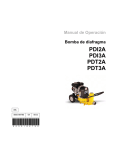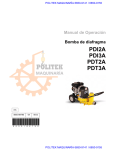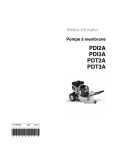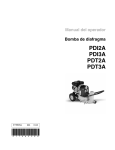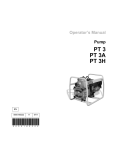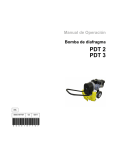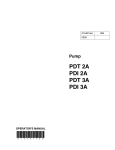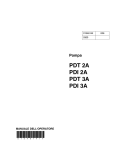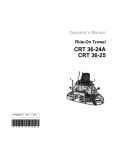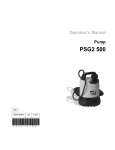Download Wacker 0620769 Instructions / Assembly
Transcript
Operator’s Manual Diaphragm Pump PDI2A PDI3A PDT2A PDT3A EN 5000184784 5 0 0 0 1 03 8 4 0811 7 8 4 Copyright notice © Copyright 2011 by Wacker Neuson Production Americas LLC All rights, including copying and distribution rights, are reserved. This publication may be photocopied by the original purchaser of the machine. Any other type of reproduction is prohibited without express written permission from Wacker Neuson Production Americas LLC. Any type of reproduction or distribution not authorized by Wacker Neuson Production Americas LLC represents an infringement of valid copyrights. Violators will be prosecuted. Trademarks All trademarks referenced in this manual are the property of their respective owners. Manufacturer Wacker Neuson Production Americas LLC N92W15000 Anthony Avenue Menomonee Falls, WI 53051 U.S.A. Tel: (262) 255-0500 · Fax: (262) 255-0550 · Tel: (800) 770-0957 www.wackerneuson.com Original instructions This Operator’s Manual presents the original instructions. The original language of this Operator’s Manual is American English. PD 2A / PD 3A Foreword Foreword SAVE THESE INSTRUCTIONS—This manual contains important instructions for the machine models below. These instructions have been written expressly by Wacker Neuson Production Americas LLC and must be followed during installation, operation, and maintenance of the machines. Machine documentation Expectations for information in this manual Machine Item Number Machine Item Number PDT 2A 0620769 PDT 3A 0620773 PDI 2A(I) 0620772 PDI 3A 0620775 PDI 3A(I) 0620776 From this point forward in this documentation, Wacker Neuson Production Americas LLC will be referred to as Wacker Neuson. Keep a copy of the Operator’s Manual with the machine at all times. Use the separate Parts Book supplied with the machine to order replacement parts. If you are missing either of these documents, please contact Wacker Neuson to order a replacement or visit www.wackerneuson.com. When ordering parts or requesting service information, be prepared to provide the machine model number, item number, revision number, and serial number. This manual provides information and procedures to safely operate and maintain the above Wacker Neuson model(s). For your own safety and to reduce the risk of injury, carefully read, understand, and observe all instructions described in this manual. Wacker Neuson expressly reserves the right to make technical modifications, even without notice, which improve the performance or safety standards of its machines. The information contained in this manual is based on machines manufactured up until the time of publication. Wacker Neuson reserves the right to change any portion of this information without notice. CALIFORNIA Proposition 65 Warning Engine exhaust, some of its constituents, and certain vehicle components, contain or emit chemicals known to the State of California to cause cancer and birth defects or other reproductive harm. Laws pertaining to spark arresters NOTICE: State Health Safety Codes and Public Resources Codes specify that in certain locations spark arresters be used on internal combustion engines that use hydrocarbon fuels. A spark arrester is a device designed to prevent accidental discharge of sparks or flames from the engine exhaust. Spark arresters are qualified and rated by the United States Forest Service for this purpose. In order to comply with local laws regarding spark arresters, consult the engine distributor or the local Health and Safety Administrator. Manufacturer’s This manual contains references to approved parts, attachments, and modificaapproval tions. The following definitions apply: wc_tx001329gb.fm 3 Foreword PD 2A / PD 3A Approved parts or attachments are those either manufactured or provided by Wacker Neuson. Approved modifications are those performed by an authorized Wacker Neuson service center according to written instructions published by Wacker Neuson. Unapproved parts, attachments, and modifications are those that do not meet the approved criteria. Unapproved parts, attachments, or modifications may have the following consequences: Serious injury hazards to the operator and persons in the work area Permanent damage to the machine which will not be covered under warranty Contact your Wacker Neuson dealer immediately if you have questions about approved or unapproved parts, attachments, or modifications. 4 wc_tx001329gb.fm EC Declaration of Conformity Manufacturer Wacker Neuson Production Americas LLC, N92W15000 Anthony Avenue, Menomonee Falls, Wisconsin USA Product Product PDT 2A, PDT2, PDI 2A(i), PDT 3A, PDT 3, PDI 3A, PDI 3A(i) Product category Water Pump Units Product function To pump fluid Item number 0620769, 0620772, 0620773, 0620775, 0620776 Net installed power PDT 2A, PDI 2A(i), PDT 3A, PDI 3A, PDI 3A(i): 2.6 kW PDT 2, PDT 3: 3.2 kW Measured sound power level 96 dB(A) Guaranteed sound power level 97 dB(A) Conformity Assessment Procedure According to ANNEX V Guidelines and Standards We hereby declare that this product meets and complies with the relevant regulations and requirements of the following guidelines and standards: 2006/42/EC, 2000/14/EC, EN 809: 1998 Authorized Person for Technical Documents Axel Häret, Wacker Neuson SE, Preußenstraße 41, 80809 München 2011-CE-PD2A_PD3A_en.fm Menomonee Falls, WI, USA, 28.04.11 William Lahner Vice President of Engineering Dan Domanski Manager, Product Engineering Original Declaration of Conformity PD 2A / PD 3A 1 Foreword 3 EC Declaration of Conformity 5 Safety Information 9 1.1 1.2 1.3 1.4 1.5 2 Table of Contents Signal Words Used in this Manual ....................................................... 9 Machine Description and Intended Use ............................................. 10 Operating Safety ................................................................................ 11 Service Safety .................................................................................... 13 Operator Safety while Using Internal Combustion Engines ............... 15 Labels 2.1 2.2 16 Label Locations .................................................................................. 16 Label Meanings .................................................................................. 17 3 Lifting and Transporting 21 4 Operation 22 4.1 4.2 4.3 4.4 4.5 4.6 4.7 4.8 4.9 4.10 4.11 Preparing the Machine for First Use ................................................... 22 Hoses and Clamps ............................................................................. 22 Recommended Fuel ........................................................................... 23 Refueling the Machine ........................................................................ 24 Before Installing the Pump ................................................................. 25 Installing the Pump ............................................................................. 26 Starting ............................................................................................... 27 Stopping ............................................................................................. 28 Running the Pump .............................................................................. 28 Clearing Jams .................................................................................... 29 Emergency Shutdown Procedure ....................................................... 30 wc_bo5000184784_03TOC.fm 7 Table of Contents 5 PD 2A / PD 3A Maintenance 5.1 5.2 5.3 5.4 5.5 5.6 5.7 5.8 5.9 5.10 31 Maintaining the Emission Control System ...........................................31 Periodic Maintenance Schedule ..........................................................32 Servicing the Air Cleaner .....................................................................33 Greasing the Connecting Rod Bearing ................................................34 Changing the Engine Oil .....................................................................35 Cleaning the Sediment Cup ................................................................36 Spark Plug ...........................................................................................37 Changing the Gearbox Oil ...................................................................38 Cleaning the Pump ..............................................................................39 Storage ................................................................................................40 6 Troubleshooting 41 7 Technical Data 43 7.1 7.2 7.3 7.4 8 Emission Control Systems Information and Warranty 8.1 9 Engine .................................................................................................43 Pump ...................................................................................................44 Sound Measurements .........................................................................44 Dimensions ..........................................................................................45 46 Emission Control Systems Warranty Statement .................................46 AEM Safety Manual 47 8 wc_bo5000184784_03TOC.fm PD 2 / PD 3 / PD 2A / PD 3A 1 1.1 Safety Information Safety Information Signal Words Used in this Manual This manual contains DANGER, WARNING, CAUTION, NOTICE, and NOTE signal words which must be followed to reduce the possibility of personal injury, damage to the equipment, or improper service. This is the safety alert symbol. It is used to alert you to potential personal hazards. f Obey all safety messages that follow this symbol. DANGER DANGER indicates a hazardous situation which, if not avoided, will result in death or serious injury. f To avoid death or serious injury from this type of hazard, obey all safety messages that follow this signal word. WARNING WARNING indicates a hazardous situation which, if not avoided, could result in death or serious injury. f To avoid possible death or serious injury from this type of hazard, obey all safety messages that follow this signal word. CAUTION CAUTION indicates a hazardous situation which, if not avoided, could result in minor or moderate injury. f To avoid possible minor or moderate injury from this type of hazard, obey all safety messages that follow this signal word. NOTICE: Used without the safety alert symbol, NOTICE indicates a situation which, if not avoided, could result in property damage. Note: A Note contains additional information important to a procedure. wc_si000391gb.fm 9 Safety Information 1.2 PD 2 / PD 3 / PD 2A / PD 3A Machine Description and Intended Use This machine is a diaphragm pump. The Wacker Neuson Diaphragm Pump consists of a gasoline engine, a fuel tank, a handle, a set of wheels, and a diaphragm pump with ports for fluid suction and discharge. The engine raises and lowers the diaphragm via a connecting rod. The operator connects hoses to the pump and routes them so that water and solids are drained from the work area and discharged into an appropriate location. This machine is intended to be used for general de-watering applications. This machine is intended for the pumping of clear water, or water containing solids up to the size stated within the product specifications, and up to the flow, head, and suction lift limits also stated within the product specifications. This machine has been designed and built strictly for the intended use described above. Using the machine for any other purpose could permanently damage the machine or seriously injure the operator or other persons in the area. Machine damage caused by misuse is not covered under warranty. The following are some examples of misuse: Pumping flammable, explosive, or corrosive fluids Pumping hot or volatile fluids that result in pump cavitation Operating the pump outside of product specifications due to incorrect diameter hoses, incorrect length hoses, other inlet or outlet restrictions, or excessive suction lift or head Using the machine as a ladder, support, or work surface Using the machine to carry or transport passengers or equipment Operating the machine outside of factory specifications Operating the machine in a manner inconsistent with all warnings found on the machine and in the Operator’s Manual This machine has been designed and built in accordance with the latest global safety standards. It has been carefully engineered to eliminate hazards as far as practicable and to increase operator safety through protective guards and labeling. However, some risks may remain even after protective measures have been taken. They are called residual risks. On this machine, they may include exposure to: Heat, noise, exhaust, and carbon monoxide from the engine Fire hazards from improper refueling techniques Fuel and its fumes Personal injury from improper lifting techniques Projectile hazard from discharge Crushing hazards from a tipping or falling pump To protect yourself and others, make sure you thoroughly read and understand the safety information presented in this manual before operating the machine. 10 wc_si000391gb.fm PD 2 / PD 3 / PD 2A / PD 3A 1.3 Safety Information Operating Safety Operator training Before operating the machine: Read and understand the operating instructions contained in all manuals delivered with the machine. Familiarize yourself with the location and proper use of all controls and safety devices. Contact Wacker Neuson for additional training if necessary. When operating this machine: Do not allow improperly trained people to operate the machine. People operating the machine must be familiar with the potential risks and hazards associated with it. Operator qualifications Only trained personnel are permitted to start, operate, and shut down the machine. They also must meet the following qualifications: have received instruction on how to properly use the machine are familiar with required safety devices The machine must not be accessed or operated by: children people impaired by alcohol or drugs Application area Be aware of the application area. Keep unauthorized personnel, children, and pets away from the machine. Remain aware of changing positions and the movement of other equipment and personnel in the application area/job site. Be aware of the application area. Do not operate the machine in areas that contain flammable objects, fuels, or products that produce flammable vapors. Safety devices, controls, and attachments Only operate the machine when: All safety devices and guards are in place and in working order. All controls operate correctly. The machine is set up correctly according to the instructions in the Operator’s Manual. The machine is clean. The machine’s labels are legible. To ensure safe operation of the machine: Do not operate the machine if any safety devices or guards are missing or inoperative. Do not modify or defeat the safety devices. Do not use accessories or attachments that are not approved by Wacker Neuson. wc_si000391gb.fm 11 Safety Information Operating guidelines PD 2 / PD 3 / PD 2A / PD 3A When operating this machine: Ensure that the machine is on a firm, level surface and that it will not tip, roll, slide, or fall while operating. When operating this machine: Do not pump volatile, flammable, or low-flash-point fluids. Do not change hoses while the engine is running. Do not attempt to move the machine while the engine is running. Personal Protective Equipment (PPE) Wear the following Personal Protective Equipment (PPE) while operating this machine: Close-fitting work clothes that do not hinder movement Safety glasses with side shields Hearing protection Safety-toed footwear 12 wc_si000391gb.fm PD 2 / PD 3 / PD 2A / PD 3A 1.4 Safety Information Service Safety Service training Before servicing or maintaining the machine: Read and understand the instructions contained in all manuals delivered with the machine. Familiarize yourself with the location and proper use of all controls and safety devices. Only trained personnel should troubleshoot or repair problems occurring with the machine. Contact Wacker Neuson for additional training if necessary. When servicing or maintaining this machine: Do not allow improperly trained people to service or maintain the machine. Personnel servicing or maintaining the machine must be familiar with the associated potential risks and hazards. Precautions Follow the precautions below when servicing or maintaining the machine. Read and understand the service procedures before performing any service to the machine. All adjustments and repairs must be completed before operation. Do not operate the machine with a known problem or deficiency. All repairs and adjustments shall be completed by a qualified technician. Turn off the machine before performing maintenance or making repairs. Personal Protective Equipment (PPE) Wear the following Personal Protective Equipment (PPE) while servicing or maintaining this machine: Close-fitting work clothes that do not hinder movement Safety glasses with side shields Hearing protection Safety-toed footwear In addition, before servicing or maintaining the machine: Tie back long hair. Remove all jewelry (including rings). Machine modifications When servicing or maintaining the machine: Use only accessories/attachments that are approved by Wacker Neuson. When servicing or maintaining the machine: Do not defeat safety devices. Do not modify the machine without the express written approval of Wacker Neuson. Replacing parts and labels wc_si000391gb.fm Replace worn or damaged components. Replace all missing and hard-to-read labels. 13 Safety Information Lifting and transporting PD 2 / PD 3 / PD 2A / PD 3A When replacing electrical components, use components that are identical in rating and performance as the original components. When replacement parts are required for this machine, use only Wacker Neuson replacement parts or those parts equivalent to the original in all types of specifications, such as physical dimensions, type, strength, and material. When lifting the machine: Make sure slings, chains, hooks, ramps, jacks, and other types of lifting devices are attached securely and have enough weight-bearing capacity to lift or hold the machine safely. See chapter Technical Data. Remain aware of the location of other people when lifting the machine. Make sure the transporting vehicle has sufficient load capacity and platform size to safely transport the machine. See chapter Technical Data. To reduce the possibility of injury: Do not stand under the machine while it is being lifted or moved. Do not get onto the machine while it is being lifted or moved. Cleaning When cleaning and servicing the machine: Keep the machine clean and free of debris such as leaves, paper, cartons, etc. Keep the labels legible. When cleaning the machine: Do not clean the machine while it is running. Never use gasoline or other types of fuels or flammable solvents to clean the machine. Fumes from fuels and solvents can become explosive. 14 wc_si000391gb.fm PD 2 / PD 3 / PD 2A / PD 3A 1.5 Safety Information Operator Safety while Using Internal Combustion Engines WARNING Internal combustion engines present special hazards during operation and fueling. Failure to follow the warnings and safety standards could result in severe injury or death. f Read and follow the warning instructions in the engine owner’s manual and the safety guidelines below. DANGER Asphyxiation hazard. Using a pump indoors CAN KILL YOU IN MINUTES. Pump exhaust contains carbon monoxide. This is a poison you cannot see or smell. f NEVER use this pump inside a home or garage, EVEN IF doors and windows are open. Only use OUTSIDE and far away from windows, doors, and vents. f NEVER use a pump inside an enclosed area, such as a tunnel or a trench, unless adequate ventilation is provided through such items as exhaust fans or hoses. Operating safety When operating the pump: Keep the area around exhaust pipe free of flammable materials. Check the fuel lines and the fuel tank for leaks and cracks before starting the engine. When operating the pump: Do not smoke while operating the machine. Do not run the machine if fuel leaks are present or the fuel lines are loose. Do not run the engine near sparks or open flames. Do not touch the engine or muffler while the engine is running or immediately after it has been turned off. Do not operate a machine when its fuel cap is loose or missing. Do not start the engine if fuel has spilled or a fuel odor is present. Move the machine away from the spill and wipe the machine dry before starting. Refueling safety When refueling the engine: Clean up any spilled fuel immediately. Refill the fuel tank in a well-ventilated area. Replace the fuel tank cap after refueling. When refueling the engine: Do not smoke. Do not refuel a hot or running engine. Do not refuel the engine near sparks or open flames. Do not refuel if the machine is positioned in a truck fitted with a plastic bed liner. Static electricity can ignite the fuel or fuel vapors. wc_si000391gb.fm 15 Labels Labels Label Locations K J C E F I G B D wc_gr007188 2.1 A 2 PD 2A / PD 3A 16 wc_si000392gb.fm PD 2A / PD 3A 2.2 Labels Label Meanings A DANGER! Asphyxiation hazard. Engines emit carbon monoxide. Do not run the machine indoors or in an enclosed area. NEVER use inside a home or garage, EVEN IF doors and windows are open. Only use OUTSIDE and far away from windows, doors, and vents. Read the Operator’s Manual. No sparks, flames, or burning objects near the machine. Stop the engine before refueling. B NOTICE Lifting point. HINWEIS AVISO AVIS C CAUTION! Grease connecting rod bearing monthly. Read the Operator’s Manual. wc_si000392gb.fm 17 Labels PD 2A / PD 3A D WARNING! Pinch point! Do not operate without safety guards. Read and understand the Operator’s Manual. E CAUTION! Read and understand the supplied Operator’s Manual before operating this machine. Failure to do so increases the risk of injury to yourself and others. F WARNING! Hot surface 18 wc_si000392gb.fm PD 2A / PD 3A Labels G Guaranteed sound power level in dB(A). I Notice Do not exceed 60 strokes per minute with the diaphragm pump. Read the Operator’s Manual. J Notice Use noncollapsible hose or pipe on suction side of pump. Read the Operator’s Manual. wc_si000392gb.fm 19 Labels PD 2A / PD 3A K WARNING! Never pump volatile, flammable, or lowflash-point fluids. These fluids could ignite or explode. Read the Operator’s Manual. 20 wc_si000392gb.fm PD 2 / PD 3 / PD 2A / PD 3A 3 Lifting and Transporting Lifting and Transporting Requirements Transport vehicle capable of carrying at least 70 kg (150 lbs.) Use lifting equipment capable of lifting at least 70 kg (150 lbs.) WARNING Fire hazard. Spilled fuel can ignite and cause severe burns. f Lift and transport the machine in an upright position. Guidelines Follow the guidelines below when lifting and transporting this machine. Close the fuel valve. Lift and transport it in an upright position. Use the lifting hook (d) to lift the machine. To secure the machine to the transport vehicle, attach strapping (b) across the handle. Also attach strapping (a) across the frame of the machine. NOTICE: Do not use the wheels or the casting (c) as tie down locations. wc_tx001371gb.fm 21 Operation 4 4.1 PD 2A / PD 3A Operation Preparing the Machine for First Use Preparing for first use To prepare your machine for first use: 1. Make sure all loose packaging materials have been removed from the machine. 2. Check the machine and its components for damage. If there is visible damage, do not operate the machine! Contact your Wacker Neuson dealer immediately for assistance. 3. Take inventory of all items included with the machine and verify that all loose components and fasteners are accounted for. 4. Attach component parts not already attached. 5. Add fluids as needed and applicable, including fuel, engine oil, and battery acid. 6. Move the machine to its operating location. 4.2 Hoses and Clamps Guidelines Follow the guidelines below for hoses and clamps. Use only noncollapsible hoses for the suction side of the pump. Note: Suction and discharge hoses are available from Wacker Neuson. Contact your nearest dealer for more information. Use two clamps for connecting suction hoses to the inlet coupling of the pump. Note: This connection is important. Even a small air leak on the suction side of pump will prevent the pump from priming. For other hose connections, one T-bolt or worm-gear type clamp is usually sufficient to hold hoses in place. In some cases, slight variances in hose diameters may make it necessary to add more clamps in order to maintain tight connections. 22 wc_tx001331gb.fm PD 2A / PD 3A 4.3 Operation Recommended Fuel Type Use of oxygenated fuels This engine/equipment requires regular unleaded gasoline. Use only fresh (no older than three months old), clean gasoline. Use a fuel stabilizer per the fuel stabilizer manufacturer’s instructions. Some conventional gasolines are blended with alcohol. These gasolines are collectively referred to as oxygenated fuels. If you use an oxygenated fuel, be sure it is unleaded and meets the minimum octane rating requirement. Before using an oxygenated fuel, confirm the fuel's contents. Some states / Provinces require this information to be posted on the fuel pump. The following are Wacker Neuson approved percentages of oxygenates: ETHANOL - (ethyl or grain alcohol) 10% by volume. You may use gasoline containing up to 10% ethanol by volume (commonly referred to as E10). Gasoline containing more than 10% ethanol (such as E15, E20, or E85) may not be used because it could damage the engine. If you notice any undesirable operating symptoms, try another service station, or switch to another brand of gasoline. Fuel system damage or performance problems resulting from the use of an oxygenated fuel containing more than the percentages of oxygenates mentioned above are not covered under warranty. wc_tx001331gb.fm 23 Operation 4.4 PD 2A / PD 3A Refueling the Machine Requirements Procedure Machine shut down Engine cool Machine/fuel tank level with the ground Fresh, clean fuel supply Perform the procedure below to refuel the machine. WARNING Fire hazard. Fuel and its vapors are extremely flammable. Burning fuel can cause severe burns. f Keep all sources of ignition away from the machine while refueling. f Do not refuel if the machine is positioned in a truck fitted with a plastic bed liner. Static electricity can ignite the fuel or fuel vapors. f Refuel only when the machine is outdoors. f Clean up spilled fuel immediately. 1. Remove the fuel cap (a). a b wc_gr008400 wc_gr008401 2. Fill the fuel tank to the bottom of the fuel tank neck (b). CAUTION Fire and health hazard. Fuel expands when heated. Expanding fuel in an over-filled tank can lead to spills and leaks. f Do not overfill the fuel tank. 3. Reinstall the fuel cap. Result The procedure to refuel the machine is now complete. 24 wc_tx001331gb.fm PD 2A / PD 3A 4.5 Operation Before Installing the Pump Requirements Tasks API GL-5 rated gear oil Machine off Perform the following tasks before installing the pump. 1. Read the safety instructions at the beginning of this manual. 2. Place the pump on a firm, flat, level surface. 3. Check fuel level. Add fuel as needed. 4. Check engine oil level. Add engine oil as needed. 5. Check condition of air filter. Replace the air filter if needed. 6. Fill the pump’s gearbox with oil. a. Remove the fill plug (a). b. Remove the level plug (b). c. Slowly pour gear oil into the fill hole until it comes out of the level hole. d. Reinstall the fill and level plugs. Result wc_tx001331gb.fm The pump is now ready to be installed. 25 Operation 4.6 PD 2A / PD 3A Installing the Pump Requirements Completed before-installing-the-pump procedures Procedure Perform the procedure below to install the pump. NOTICE: Do not use collapsible hoses on the suction side of the pump. 1. Place the pump as near to the water to be pumped as possible. 2. Check that hose couplings/nipples (b) are installed and secure. 3. Make sure the suction strainer (e) is clean and securely attached to the end of the suction hose. 4. Connect the suction hose (d) to the pump with two clamps (c). Position the suction hose so that: there is a continual upward slope from the water source to the pump the suction hose/strainer in the water source will stay submerged as the water source level drops the suction hose is as short as possible there are no loops in the suction hose there are no air leaks. 5. Connect the discharge hose (f) to the pump with clamp (g). 6. Lay the discharge hose (f) out as straight as possible. Position the discharge hose so that: there are no sharp bends or loops in the hose the hose is less than 8.1 m (25 ft) above or away from the pump the hose is not a tripping hazard on the job site. NOTICE: Maximum discharge head is 8.1 m (25 ft) or 0.8 bar (10.9 psi). Operating the pump over this head or pressure will cause the pump to stall and/or gearbox damage. 26 wc_tx001331gb.fm PD 2A / PD 3A 4.7 Operation Starting Requirements Procedure Completed installation procedures Engine owner’s manual read and understood Perform the procedure below to start the machine. 1. Move the fuel valve lever (a) to the OPEN position (a1). 2. Move the choke lever (b) to the CLOSED position (b1). If the engine is warm, the choke lever may be left in the OPEN position (b2). 3. Move the throttle lever (c) approximately 1/3 of the way to the “MAX.” position. 4. Turn the engine switch (d) to the ON position (d1). 5. Pull the starter rope until the engine starts. 6. Move the choke lever to the OPEN position as the engine warms. 7. Move the throttle to “MAX.” position to run the pump. wc_tx001331gb.fm 27 Operation 4.8 PD 2A / PD 3A Stopping Procedure Perform the procedure below to stop the machine. Note: To stop the engine in an emergency, move the engine switch to the OFF position. In all other circumstances, use the following procedure. 1. Move the throttle lever (c) to “MIN.” position. 2. Turn the engine switch (d) to the OFF position (d2). 3. Move the fuel valve lever (a) to the CLOSED position (a2). 4.9 Running the Pump Guidelines Follow the guidelines below when running the pump. Run the engine at full speed. NOTICE: Pump speed must not exceed 60 strokes per minute. The pump should begin pumping water within one minute of being started depending on hose length and height above water. Longer hoses will require more time. If the pump does not prime: a. check for loose fittings, air leaks, and plugged strainer. b. stop the engine, remove plug (a), add water, reinstall plug, and restart the engine. 28 wc_tx001331gb.fm PD 2A / PD 3A 4.10 Operation Clearing Jams Overview Prerequisites Large solids or accumulated sand and sediment may become lodged in the pump housing. This debris prevents the plunger arm from making a full stroke, causing the pump to stall or the crank to slip on the output shaft. The debris must be cleared before resuming operation. If the pump has stalled Engine is stopped Machine is cool to the touch Follow the procedure below to clear a jam if the pump has stalled. a e f b c d wc_gr008182 1. Remove the handle (a). 2. Remove the four bolts (b) securing the pump housing (c). 3. Clean all debris and obstructions from the pump housing. 4. Re-install the four bolts and handle. If the crank is slipping Follow the procedure below to re-tighten the crank if a jam has caused it to slip. 1. Loosen the hand knob screws (d) and remove the metal guard (e). 2. Remove the handle and bolts as described in the above procedure. 3. Clean all debris and obstructions from the pump housing. 4. Loosen the crank lockscrew (f). Re-torque the crank lockscrew to 95 Nm (70 ft.lbs.) NOTICE: Do not over-torque or under-torque the lockscrew! Improper torque can break the connecting rod or cause premature wear of internal parts. 5. Re-install the metal guard, handle, and bolts. wc_tx001331gb.fm 29 Operation 4.11 PD 2A / PD 3A Emergency Shutdown Procedure If a breakdown/accident occurs while the machine is operating, follow the procedure below. 1. Stop the engine. 2. Turn off the fuel. 3. Remove the obstruction. 4. Unkink the hoses. 5. Allow the machine to cool. 6. Contact the rental yard or machine owner. 30 wc_tx001331gb.fm PD 2A / PD 3A 5 5.1 Maintenance Maintenance Maintaining the Emission Control System Normal maintenance, replacement or repair of emission control devices and systems may be performed by any repair establishment or individual; however, warranty repairs must be performed by a dealer/service center authorized by the engine manufacturer. See the supplied engine owner’s manual for the applicable emission warranty information. wc_tx001332gb.fm 31 Maintenance 5.2 PD 2A / PD 3A Periodic Maintenance Schedule The table below lists basic machine and engine maintenance. Tasks designated with check marks may be performed by the operator. Tasks designated with square bullet points require special training and equipment. Refer to the engine owner’s manual for additional information. Interval* (hours of service) Task Daily before starting First month Monthly 6 months Yearly --- (20) (40) (100) (300) Check fuel level. 3 Check engine oil level. 3 Inspect air cleaner elements. Replace as needed. 3 Check external hardware. 3 Grease connecting rod bearing. Change engine oil. Check oil level in pump gearbox. Clean engine sediment cup. Clean spark plug. Change oil in pump gearbox. Check and adjust valve engine clearances Check and adjust idle speed Replace fuel filter * Use whichever comes first, calendar time or service hours. 32 wc_tx001332gb.fm PD 2A / PD 3A 5.3 Maintenance Servicing the Air Cleaner When Requirements Inspect the air cleaner elements daily. Clean the air cleaner elements as needed. Replace the air cleaner elements if they are damaged or cannot be cleaned. Machine shut down Mild detergent and warm water Clean engine oil WARNING Fire or explosion hazards. Gasoline or low-flash-point solvents are flammable and must not be used to clean the air cleaner or filter element. f Use only mild detergent and warm water to clean the air cleaner and filter element. NOTICE: Do not run the engine without the air cleaner or filter elements. Severe engine damage will occur! Procedure Follow the procedure below to service the air cleaner. 1. Stop the engine. 2. Remove the wing nut (a) and remove the air cleaner cover (b). 3. Remove the second wing nut (c) and remove the air filter. Note: The air filter has two elements: a foam element and a paper element. 4. Remove the foam element (e) from the paper element (d). 5. Clean the elements if they are to be reused. Paper element a. Tap the paper element on a hard surface to remove dirt, or blow low-pressure (less than 207 kPa (30 psi)) through the paper element from the inside. NOTICE: Do not try to brush dirt off the paper element. Brushing will force dirt into the fibers of the paper element. Foam element a. Wash the foam element in a solution of mild detergent and warm water. b. Rinse the foam element thoroughly in clean water, and allow it to dry completely. wc_tx001332gb.fm 33 Maintenance PD 2A / PD 3A c. Soak the foam element in clean engine oil until saturated. Squeeze out excess oil. 6. Reinstall the filter elements and air cleaner cover. Note: In the interests of environmental protection, dispose of waste oil and soiled rags in accordance with environmental protection legislation. 5.4 Greasing the Connecting Rod Bearing When Grease the connecting rod bearing every 40 hours of operation or monthly. Requirements Procedure General automotive grease Machine shut down Perform the procedure below to grease the connecting rod bearing. 1. Stop the engine. 2. Access the grease fitting of the connecting rod bearing through the access hole (a). 3. Using a grease gun, pump grease into the fitting until new grease seeps out between the bearing and the journal. 34 wc_tx001332gb.fm PD 2A / PD 3A 5.5 Maintenance Changing the Engine Oil When Requirements Change the engine oil after the first 20 hours of operation and then after every 100 hours of operation or 6 months, whichever comes first. Warm engine Plastic sheet to protect against drips or spills Container of sufficient volume to collect waste oil Replacement oil (see Technical Data for quantity and type) New gasket WARNING Most used oil contains small amounts of materials that can cause cancer and other health problems if inhaled, ingested, or left in contact with skin for prolonged periods of time. f Take steps to avoid inhaling or ingesting used engine oil. f Wash skin thoroughly after exposure to used engine oil. Procedure Perform the procedure below to replace the engine oil. 1. Position the machine on a flat, level surface. 2. Stop the engine. 3. Place the plastic sheet and container under the engine. 4. Remove the drain plug (a) and allow the oil to drain. 5. Reinstall the drain plug with a new gasket. 6. Remove the dipstick (b) and wipe it clean. 7. Fill the engine crankcase with fresh oil through the filler opening (c). Check the oil level by inserting the dipstick into the filler opening. Do not thread the dipstick into the engine to check the oil level. Fill the crankcase so that the oil level reaches the upper mark on the dipstick. Note: u = crankcase upper limit; l = crankcase lower limit 8. Reinstall the dipstick. Note: In the interests of environmental protection, dispose of waste oil and soiled rags in accordance with environmental protection legislation. wc_tx001332gb.fm 35 Maintenance 5.6 PD 2A / PD 3A Cleaning the Sediment Cup When Clean the engine sediment cup every 100 hours or 6 months. Requirements Procedure Machine shut down Nonflammable solvent Perform the procedure below to service the sediment cup. 1. Stop the engine. 2. Move the fuel valve to the OFF position. 3. Remove the sediment cup (a) and the O-ring (b). WARNING Fire hazard. Gasoline or low-flash-point solvents are flammable and may ignite if used to clean the machine. f Use only nonflammable solvents when cleaning the sediment cup. 4. Wash the sediment cup and the O-ring thoroughly in a nonflammable solvent. Dry and reinstall them. 5. Move the fuel valve to the ON position and check for leaks. 36 wc_tx001332gb.fm PD 2A / PD 3A 5.7 Maintenance Spark Plug When Requirements Clean the spark plug every 100 hours of operation or every 6 months. Replace the spark plug as needed. Procedure Machine shut down Engine cool Perform the procedure below to clean the spark plug. WARNING Burn hazard. The engine and muffler become very hot while running. f Allow the engine to cool before performing this procedure. 1. Stop the engine and allow it to cool. 2. Remove the spark plug. 3. Inspect the spark plug. Replace the spark plug if the insulator is cracked or chipped, or if the electrode is damaged. 4. Clean the spark plug with a wire brush. 5. Set the electrode gap (a). See chapter Technical Data for the recommended gap. 6. Reinstall the spark plug and tighten it to the recommended torque from the engine owner’s manual. NOTICE: A loose spark plug can become very hot and may cause engine damage. wc_tx001332gb.fm 37 Maintenance 5.8 PD 2A / PD 3A Changing the Gearbox Oil When Change the gearbox oil every 100 hours of operation or every 6 months. Requirements Procedure Machine shut down Engine warm API GL-5 rated gear oil Container for used oil Perform the procedure below to change the gearbox oil. WARNING Burn hazard. The engine and muffler become very while running. f Stop the engine before performing this procedure. 1. Stop the engine. 2. Remove the drain plug (a) and drain the oil into a suitable container. 3. Reinstall the drain plug. 4. Remove the fill plug (b) and the level plug (c). 5. Slowly pour gear oil into the fill hole until it comes out of the level hole. 6. Reinstall the fill and level plugs. Note: In the interests of environmental protection, dispose of waste oil and soiled rags in accordance with environmental protection legislation. 38 wc_tx001332gb.fm PD 2A / PD 3A 5.9 Maintenance Cleaning the Pump Requirements Machine shut down Machine cool Background When pumping heavy sludges or water containing large amounts of dirt and solids, clean the pump often. Materials left in the pump can dry and harden which may lead to damage of the valves or the diaphragm. Procedure Perform the procedure below to clean the machine. WARNING Fire hazard. Gasoline or low-flash-point solvents are flammable and may ignite if used to clean the machine. f Do not use flammable solvents to clean the machine. 1. Pump clean water through the pump for a few minutes. 2. Stop the engine and allow the machine to cool. 3. Remove the dirt from in between the engine cooling fins. 4. Remove the pump cover (a) and clean dirt and grease build-up from the connecting rod and from the inside of the pump cover. 5. Reinstall the pump cover. wc_tx001332gb.fm 39 Maintenance 5.10 PD 2A / PD 3A Storage Requirements Procedure Machine shut down Machine cool Machine clean Perform the procedure below to store the machine for more than 30 days. WARNING Fire hazard. The machine may cause a fire if it is covered while it is hot. f Do not cover the machine while it is running or while it is hot. 1. Stop the engine. 2. Change the engine oil. 3. Cover the pump. 4. Store the pump in a clean, dry location. 40 wc_tx001332gb.fm PD 2 / PD 3 / PD 2A / PD 3A 6 Troubleshooting Troubleshooting Problem Cause Remedy Engine does not start Engine oil level too low Add oil to engine. Pump housing filled with dirt and debris Clean pump. Air leak in suction line Repair or replace suction line. Defective flapper valve Replace the flapper valves. Clogged strainer Clean or replace the strainer. No liquid in suction line Fill the pump and suction line with water. Pump housing filled with dirt and debris Clean pump. Incorrect engine speed Check engine speed. Hoses are damaged Replace the hoses. Too many bends in the hoses Straighten the hoses. Hoses are too long Shorten the hoses. Faulty suction hose Replace the suction hoses. Pump located too far from fluid source Place the pump closer to the source. Flapper valve closed Clean or replace the flapper valves. Clogged strainer Unclog or replace the strainer. Height of discharge hose above pump is too great Lower the discharge hose. Leak in suction hose Repair or replace the suction hose. Diaphragm has crack or hole Replace the diaphragm. Defective or clogged flapper valves Clean or replace the flapper valves. Pump not secured to firm foundation Secure the pump. Restricted suction hose Clean or replace the suction hose. Pump does not prime Flow rate is slow Pump runs but no fluid is pumped Pump pumps erratically Excessive noise while pumping wc_tx001382gb.fm 41 Troubleshooting PD 2 / PD 3 / PD 2A / PD 3A Problem Cause Remedy Water accumulates on top of the diaphragm Diaphragm has crack or hole. Replace the diaphragm. Screw loose holding diaphragm Tighten the screw. Discharge hose height over 25 feet of head Lower the discharge hose. Pump housing filled with dirt and debris Clean the pump. Pump stalls repeatedly or stops for no apparent reason 42 wc_tx001382gb.fm PD 2A / PD 3A 7 Technical Data Technical Data 7.1 Engine Engine Power Rating Net power rating per SAE J1349. Actual power output may vary due to conditions of specific use. Engine PDI 2/PDT 2 PDI 3/PDT 3 Type — Air-cooled Manufacturer — Honda Model — GX 120K1QX Maximum rated power at rated speed Displacement Number of cylinders Oil capacity kW/rpm (hp/rpm) cm3 (in.3) — ml (oz.) 2.6/3600 (3.5/3600) 118 (7.2) 1 600 (20) Oil type — 10W30 API SJ, SL or equivalent Fuel type — Regular unleaded gasoline Fuel tank capacity L (qt) 2.5 (2.6) Fuel consumption L/hr (qt/hr) 1.1 (1.2) Running time hr 2.2 Spark plug type — NGK BPR6HS mm (in.) 0.70–0.80 (0.028–0.031) Electrode gap wc_td000379gb.fm 43 Technical Data 7.2 PD 2A / PD 3A Pump Machine PDI 2/PDT 2 PDI 3/PDT 3 50 (2) 75 (3) kg (lb) 59 (131) 63 (140) Maximum discharge head m (ft) 7.6 (38) 7.6 (38) Maximum flow rate L/min (gpm) 189 (50) 333 (88) Maximum suction lift m (ft) 6.1 (20) 6.1 (20) mm (in.) 38 (1.5) 41 (1.625) Suction and discharge hose diameter Operating weight Maximum solid size diameter 7.3 mm (in.) Sound Measurements The required sound specification, Paragraph 1.7.4.u of 2006/42/EC Machinery Directive, is: the guaranteed sound power level (LWA) = 97 dB(A). the sound pressure level at operator’s location (LpA): PDT 2 = 85, PDI 2 = 85, PDT 3 = 85, PDI 3 = 85 These sound values were determined according to ISO 3744 for the sound power level (LWA) and ISO 6081 for the sound pressure level (LpA) at the operator’s location. 44 wc_td000379gb.fm PD 2A / PD 3A 7.4 Technical Data Dimensions PD2 590 (23) PD3 590 (23) PD2 1000 (40) PD3 1070 (42) PD2 580 (23) PD3 680 (27) PD2 590 (23) PD3 590 (23) PD2 460 (18) PD3 460 (18) PD2 1000 (40) PD3 1070 (42) wc_gr007189 wc_td000379gb.fm 45 Emission Control Systems Information and Warranty 8 Emission Control Systems Information and Warranty The Emission Control Warranty and associated information is valid only for the U.S.A., its territories, and Canada. 8.1 Emission Control Systems Warranty Statement See the supplied engine owner’s manual for the applicable exhaust and evaporative emission warranty statement. 46 wc_tx001753gb.fm Wacker Neuson Produktion GmbH & Co. KG, Preußenstraße 41, D-80809 München, Tel.: +49-(0)89-3 54 02-0 Fax: +49 - (0)89-3 54 02-390 Wacker Neuson Production Americas LLC, N92W15000 Anthony Ave., Menomonee Falls, WI 53051 Tel. : (262) 255-0500 Fax: (262) 255-0550 Tel.: (800) 770-0957 Wacker Neuson Limited - Room 1701–03 & 1717–20, 17/F. Tower 1, Grand Century Place, 193 Prince Edward Road West, Mongkok, Kowloon, Hongkong. Tel: (852) 3605 5360, Fax: (852) 2758 0032




























































